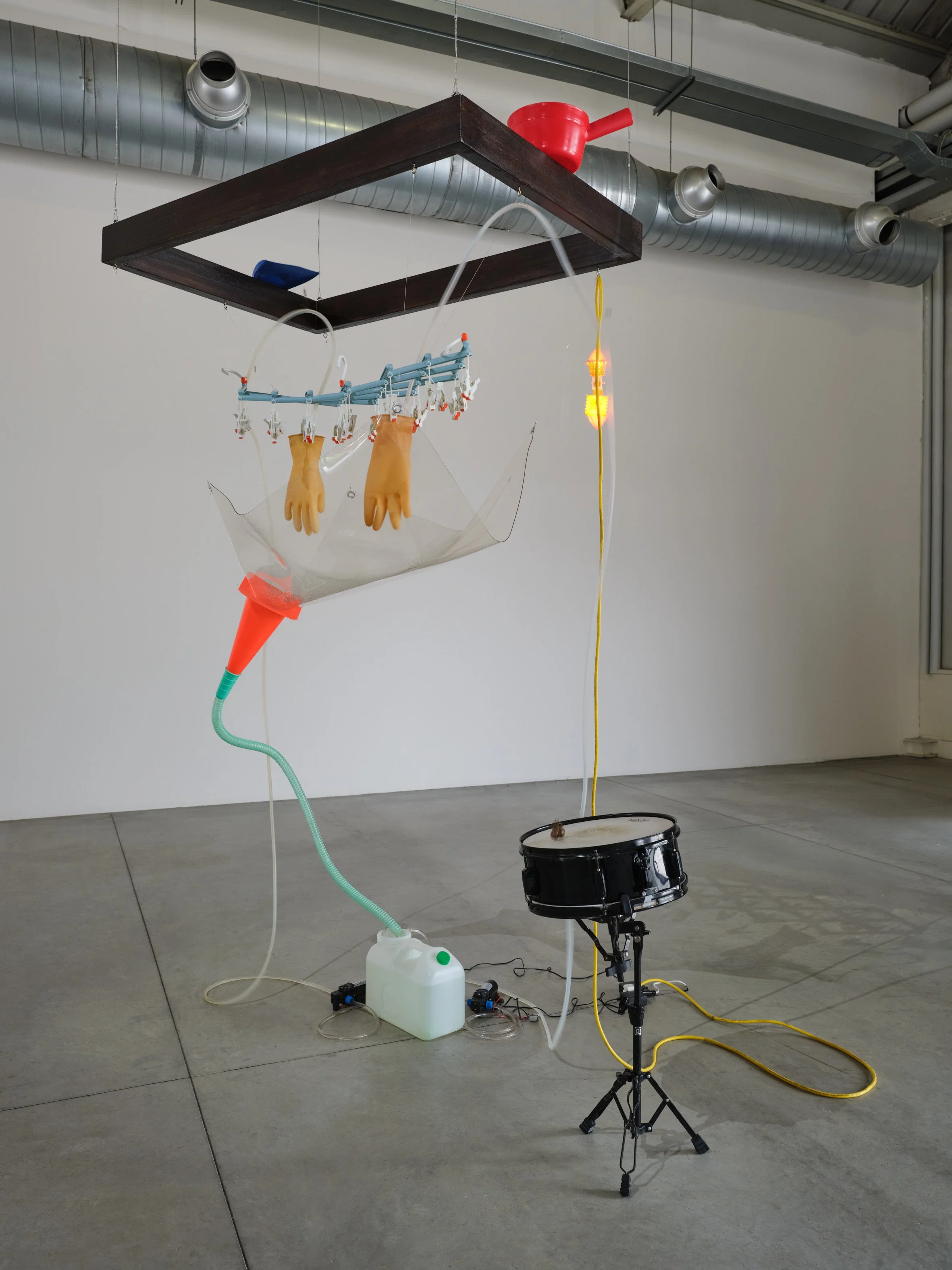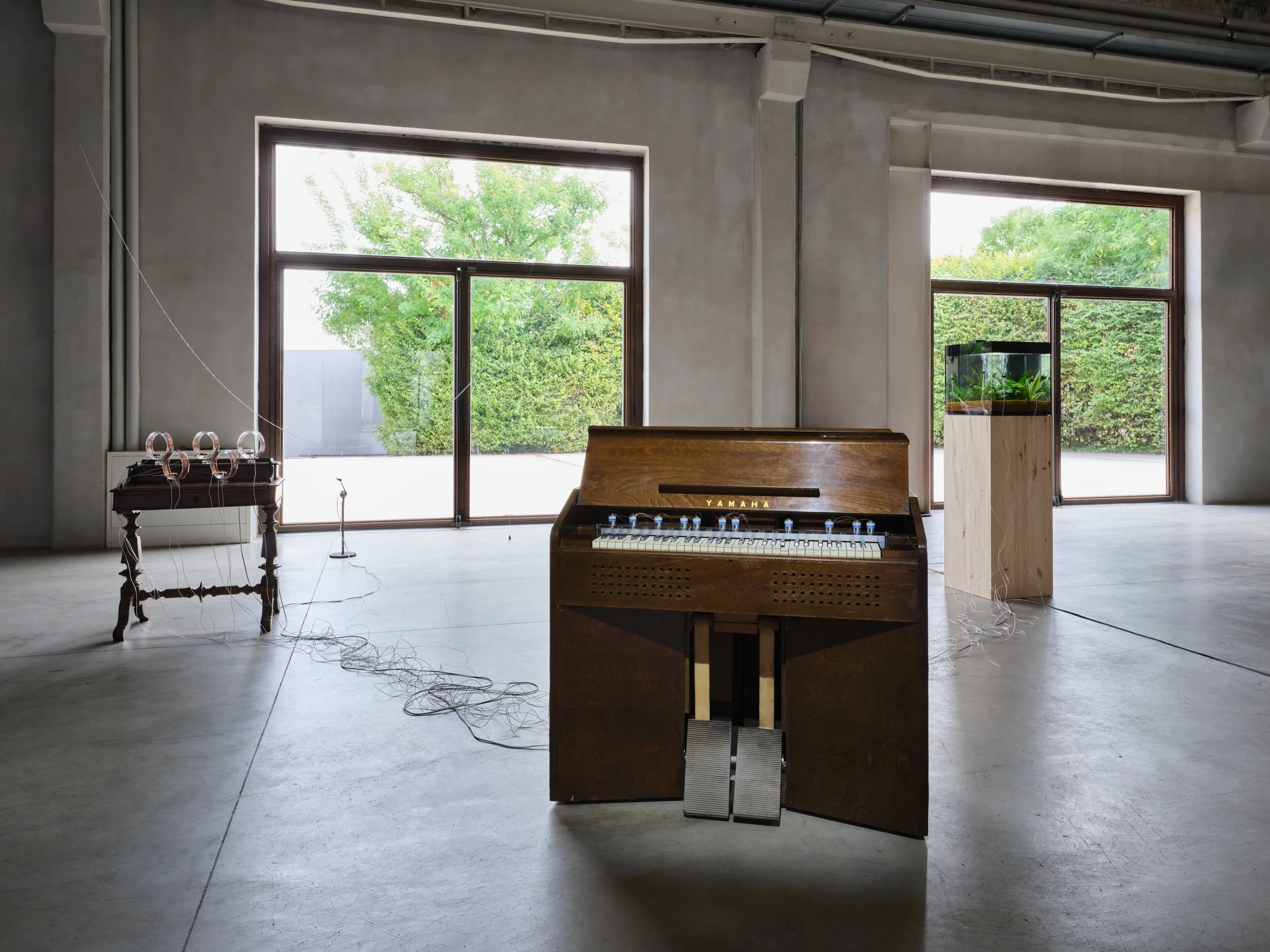The Fish that Plays the Reed Organ
There’s a long ribbon of white that descends onto the entrance of Yuko Mohri’s solo show, Entanglements, at Pirelli HangarBicocca. With the delicate gusts of wind that find their way into the exhibition space, it twists and spirals from the ceiling. It shifts in tones and shadows from the daylight that comes in through floor-to-ceiling glass windows. Looking up at the hulking metal truss that holds the ribbon’s source, its true nature is revealed—this is a roll of two-ply toilet paper.
Although the curation team was a bit perplexed when they discovered the exhibition’s finishing touch to appear over the weekend, they laughed as they pointed it out on the ceiling: to appreciate art, shouldn’t one be able to submit to an object’s true essence? A hygienic tool, a silly bit of toilet humor.
Entanglements has a noticeable abundance of stuff—knick-knacks, doodads, gadgets—scattered around the space. The accumulation of things places the artist somewhere between Temu victim and MacGyver genius, arranged ever so carefully with a bit of Calder panache. Surrounded by her cabinet of curiosities, Mohri’s work contemplates our relationship to quotidian objects. It challenges the notion that they are mere extensions of ourselves, tools that augment human capabilities. Instead, there’s a humility in it that suggests we are no bigger than a speck of dust, no more powerful than a feather.
For Moré Moré (Leaky) (2018), the installation mimics the informal, yet innovative patchwork of solutions that would arise from workers in the Japanese metro system haphazardly rushing to fix a leak. In a parody of these infrastructure solutions, Mohri finds joy in the adornment of a plastic tube with an oversized metal whisk. There’s a certain giddiness in the heinously orange traffic cone she’s flipped over to act as a funnel. In these spontaneous, yet calculated arrangements, the artist grants each object in her composition another life. The silver kettle isn’t just a tool for making a cup of tea—its plump body and curving spout are happy to provide salvation from a plumbing system in disrepair.
On the other side of the hall, a tank of goldfish with bulging eyes acts as one of the sensory inputs of Flutter (2018/2015). Polka-dotted with white round sensors tethered to wires, it looks as though the aquarium is getting an electroencephalogram. Nearby, a gently swaying chain drapes from the ceiling. Atop a wooden table, a collection of compasses twitch as their true north gets disrupted by surrounding copper loops.
Together, their disparate movements incite a performance from the reed organ at Flutter’s center. Through a mysterious system of triggers, sensors, and circuit boards, Mohri imbues a certain autonomy to a string of linked metal or a dysfunctional compass. As they produce a song, they come to life as their own actors, subverting the traditional notion of these objects as things to be acted upon. Instead, they are their own players.
There’s a charm to the clutter that can be traced to Mohri’s early years in Akihabara, Japan’s neon electronics district. It’s a part of Tokyo where towering anime posters and buckets of plastic goods overflow from their shops. Here she could get second-hand appliances and basic electronic parts. In the assemblages she was able to create, electricity became a means of giving her objects their agency.
Agency here doesn’t mean these objects have desires, but that Mohri’s systems redistribute causality—it subverts the traditional anthropocentric hierarchy of man and his domain. Instead, she flips the power dynamic by pondering, What could the lightest breeze possibly change?
Mimicking the toilet paper’s draping form is Mohri’s I/O (2011–). The sculpture consists of two rigs, suspended from the ceiling. Each contains a long scroll of white paper that’s dragged along the exhibition floor before being fed into a sensor. It then reads the dust specks that accumulate on the surface and triggers a chorus of objects to respond.
Then, there’s a set of hanging light bulbs that flicker on and off. A propped-up bell lyre—a type of swirly glockenspiel that looks like an upright xylophone—twinkles as it’s played by a descending set of wires adorned with plastic buttons. Feather dusters flap along the floor to move the sediment that will eventually find its way back to the surface of the paper. As I/O gently proceeds with its dramaturgy, it visualizes how even the smallest of particles can have their own cascading effect on the world.
Mohri’s work is a collection of seemingly inconsequential objects that, through a process of habituation, have become invisible. They are brushed aside tchotchkes that collect dust on a shelf. It’s the wonky whisk that really needs replacing. But in Mohri’s compositions, they are characters that dance and sing, and play instruments. If we listen closely, we find a concert already underway, played by the things beyond us.
Yuko Mohri: Entanglements is on view at Pirelli HangarBicocca from September 9, 2025 through January 11, 2026.





